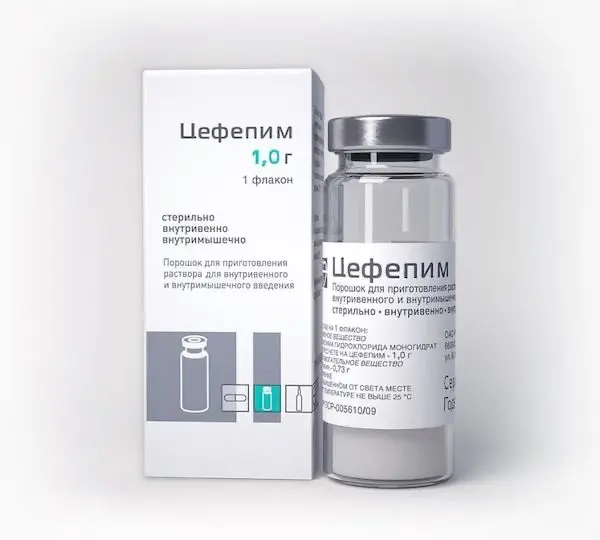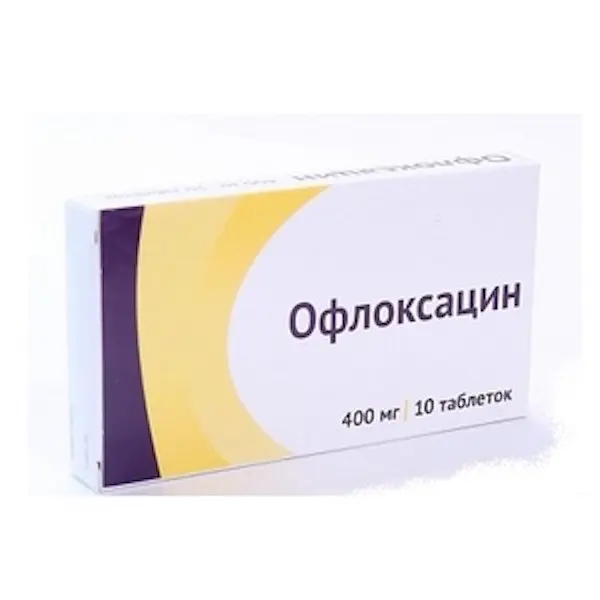Description
Cefepim Pharmacodynamics
Generation IV cephalosporin antibiotic for parenteral use. It has a broad spectrum of action against Gram-positive and Gram-negative bacteria, including strains resistant to aminoglycosides and/or III generation cephalosporins and other antibiotics. It acts bactericidally by disrupting the final stages of bacterial cell wall synthesis (inactivates the enzyme transpeptidase). It quickly penetrates through the outer membrane of Gram-negative bacteria; it has high affinity to penicillin-binding proteins, or bacterial transpeptidases. It is highly resistant to hydrolysis by most beta-lactamases. Cefepim is active against the following microorganisms:
Gram-positive aerobes: Staphylococcus aureus (including beta-lactamase-producing strains); Staphylococcus epidermidis (including beta-lactamase-producing strains); other strains of Staphylococcus spp, including, Staphylococcus hominis, Staphylococcus saprophytics; Streptococcus pyogenes (group A streptococci); Streptococcus agalactiae (group B streptococci); Streptococcus pneumoniae (including medium penicillin-resistant strains – minimum suppressive concentration 0.1 to 1 µg/ml); other beta-hemolytic Streptococcus spp. (groups C, G, F), Streptococcus bovis (group D), Streptococcus spp. group Viridans.
Gram-negative aerobes: Acinetobacter calcoaceticus (sub strains anitratus, hvoffii);
Aromonas hydrophila; Capnocytophaga spp.; Citrobacter spp. including Citrobacter diversus, Citrobacter freundii; Campylobacter jejuni; Enterobacter spp, including Enterobacter cloacae, Enterobacter aerogenes, Enterobacter sakazakii, Escherichia coli, Cardnerella vaginalis, Haemophilus ducreyi; Haemophilus influenzae (including beta-lactamase producing strains); Haemophilus parainfluenzae; Hafnia alvei; Klebsiella spp, including Klebsiella pneumoniae, Klebsiella oxytoca, Klebsiella ozaena; Morganella morganii; Moraxella catarrhalis (Branhamella catarrhalis) (including beta-lactamase producing strains); Neisseria gonorrhoeae (including beta-lactamase-producing strains); Neisseria meningitidis; Pantoea agglomerans (formerly known as Enterobacter agglomerans); Proteus spp. , including Proteus mirabilis, Proteus vulgaris; Providencia spp. including Providencia rettgeri, Providencia stuartii; Pseudomonas spp. including Pseudomonas aeruginosa, Pseudomonas itida, Pseudomonas stutzeri; Salmonella spp; Serratia including Serratia marcescens, Serratia liquefaciens; Shigella spp; Yersinia enterocolitica.
Anaerobes: Clostridium perfringens; Fusobacterium spp; Mobiluncus spp; Peptostreptococcus spp; Prevotella melaninogenica, known as Bacteroides melaninogenicus; Veillonella spp. Cefepim is inactive against many strains of Stenotrophomonas maltophilia, formerly known as Xanthmonas maltophilia and Pseudomonas maltophilia (Gram-negative aerobes); against Bacteroides fragilis and Clostridium difficile (anaerobes). Most strains of enterococci, such as Enterococcus faecalis, and methicillin-resistant staphylococci are resistant to most cephalosporin antibiotics, including cefepime. Inactive against many strains of Stenotrophomonas maltophilia (formerly known as Xanthomonas maltophilia and Pseudomonas maltophilia), Bacteroides fragilis and Clostridium difficile.
Indications
Infectious-inflammatory diseases caused by cefepim-sensitive microorganisms in adults:
– Lower respiratory tract infections, including pneumonia and bronchitis;
– urinary tract infections, both complicated, including pyelonephritis, and uncomplicated,
– Skin and soft tissue infections;
– abdominal infections, including peritonitis and biliary tract infections;
– gynecologic infections;
– septicemia;
– Febrile neutropenia.
Prevention of possible infections during cavity surgical procedures.
Infectious and inflammatory diseases caused by cefepim-sensitive microorganisms in children:
– pneumonia;
– urinary tract infections, both complicated, including pyelonephritis, and uncomplicated;
– Skin and soft tissue infections;
– septicemia;
– febrile neutropenia;
– bacterial meningitis.
Contraindications
Hypersensitivity to cefepime, arginine, as well as to cephalosporins, penicillins and other beta-lactam antibiotics. Childhood under 2 months of age.
Pregnancy and lactation:
In pregnancy, the drug is used only if the anticipated benefit to the mother exceeds the risk to the fetus.
Dosage and administration method
- Intravenous (IV), intramuscular (IV/m). Doses and route of administration depend on pathogen sensitivity, severity of infection, state of nocicular function and general condition of the patient. Intravenous administration is recommended for patients with severe or life-threatening infections, especially at the risk of septic shock.
- Adults and children over 40 kg with normal renal function:
- – mild to moderate urinary tract infections – 0.5-1 g v/v or v/m every 12 h;
- – Infections of mild to moderate other localizations – 1 g iv or v/m every 12 hours;
- – severe infections – 2 g w/v every 12 hours;
- – very severe and life-threatening infections, including febrile neutropenia – 2 g w/v every 8 hours.
- Usual duration of treatment is 7-10 days; severe infections may require longer treatment. In treatment of febrile neutropenia the usual duration of treatment is 7 days or until neutropenia disappears.
- Prophylaxis of infection during surgical operations: 60 minutes before the beginning of the surgical operation, 2 g of the drug is infused intravenously for 30 minutes.
- Immediately after the end of the infusion 0.5 g of metronidazole is administered intravenously. Due to pharmaceutical incompatibility, metronidazole and cefepime solutions should not be mixed in the same bottle of infusion solution. The infusion system should be flushed before administration of metronidazole. During prolonged (more than 12 hours) surgical procedures, 12 hours after the first dose, a second administration of cefepime at the same dose followed by administration of metronidazole is recommended.
- Children from 2 months of age with body weight up to 40 kg:
- – urinary tract infections, skin and soft tissue infections, pneumonia – 50 mg/kg v/v or v/m 2 times a day for 10 days; in case of severe infections – every 8 hours;
- – febrile neutropenia, septicemia, bacterial meningitis – 50 mg/kg every 8 hours for 7-10 days.
- The dose for children should not exceed the maximum recommended dose for adults – 2 g v/v every 8 hours. There is limited experience in administering the drug intravenously in children.
- From the known serum creatinine concentration, calculate creatinine clearance using the formula:
- For men:
- Body weight (kg) x (140 – age in years)
- Creatinine clearance (ml/min) 72 x serum creatinine (mg/100 ml)
- For women: use the same formula, multiplying the result by 0.85.
- In continuous ambulatory peritoneal dialysis, the recommended maintenance doses are 0.5 g, 1 g, or 2 g, depending on the severity of the infection, with an interval of 48 hours between injections.
- Patients on hemodialysis – 1 g during the first day of treatment and then 0.5 g every 24 hours in all infections, except for febrile neutropenia, where the dose is 1 g every 24 hours. On hemodialysis days, the drug should be administered at the end of the hemodialysis procedure. If possible, the drug should be administered at the same time each day.
- In children with impaired renal function it is recommended to reduce the dose or increase the interval between the injections as indicated (see the instructions).
- Preparation and administration of the drug solutions
- Intravenous stream administration: 0.5 g or 1.0 g of the preparation is dissolved respectively in 5 ml or 10 ml of water for injection, 5% dextrose solution or 0.9% sodium chloride solution (the volume of obtained solution is respectively 5.7 ml or 11.4 ml, approx. cefepime concentration is 90 mg/ml). It is administered intravenously slowly over 3-5 minutes directly into a vein or through an IV system, together with a compatible IV solution.
- Intravenous drip administration: the prepared solution (see above) is transferred to a bottle containing 50-100 ml of compatible solution for infusion. Administer via a system for intravenous infusion for at least 30 minutes. The drug solutions with 1-40 mg/ml concentration are compatible with the following infusion solutions: 0.9% sodium chloride solution; 5% or 10% dextrose solution; 1/6 M sodium lactate solution, 5% dextrose solution and 0.9% sodium chloride solution; Ringer’s lactate solution.
- Intramuscular administration: 0.5 g or 1.0 g of the drug is dissolved respectively in 1.5 ml or in 3 ml of water for injection, 0.9% sodium chloride solution, bacteriostatic water for injection, 0.5% or 1% lidocaine solution (the volume of obtained solution is respectively 2.2 ml or 4.4 ml, approx. cefepime concentration 230 mg/ml). The obtained solution is injected deeply intramuscularly into areas of the body with a pronounced muscular layer (upper outer quadrant of the buttock or lateral surface of the thigh). An aspiration test is recommended to avoid unwanted injection of the solution into a blood vessel. A dose of up to 1 g can be administered as a single injection.





